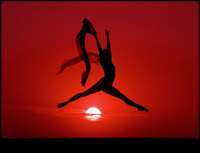 Ballet, to me, is the telling of a story, the emotions of it through line of the body, the movements, the gestures set to music. The controlled and contained movements give it that effortless, ethereal quality that captivates. Ballet dancers study for years to master and attain the physical abilities necessary to achieve this look and feel.
Ballet, to me, is the telling of a story, the emotions of it through line of the body, the movements, the gestures set to music. The controlled and contained movements give it that effortless, ethereal quality that captivates. Ballet dancers study for years to master and attain the physical abilities necessary to achieve this look and feel.
Thinking back of who some of the great Ballet stars were at the time I was growing up: names come to mind like Rudolf Nureyev, Margot Fonteyn, Natalia Makarova, Mikhail Baryshnikov to name just a few. What was it about their dancing that lead them to fame – what were the qualities of the way they moved that gave them that effortless grace, that spontaneity of movement that also captured the emotion of the dance – what were the physics of it in play that made it seem so effortless?
In her new book, “Apollo’s Angels: A History of Ballet”, author Jennifer Homans describes ballet this way: “At the origins of ballet lay two ideas: the formal mathematical precision of the human body and the universality of human gesture”.
Perhaps one way this formal, mathematical precision of the body can be described – is that it’s the push pull movement between one end of a limb (or one end of the entire body) pushing or pulling in the opposite direction of the other end – so that the extension of this other end lengthens it into the illusion of infinity – the lengthening of that line into what’s called “extension”. And, all the while, the body is trained so that it’s strong enough to be held in place while the limbs accomplish these movements or are held still.
I asked one of my teachers, Sally Miramon, of The Alonzo King Lines Dance Center in San Francisco, to comment on this. Here’s what Sally had to say about this:
“There are many reasons for ballet dances to appear effortless and graceful. As a teacher, or choreographer, the dancer must have at least the following 5 elements:
1) Musicality – The ability to fit a dance to the music being played, by relating the dance to the music’s rhythm, melody, and mood.
2) Technical control/ training to execute movement with the proper timing and required spatial range
3) Core strength to hold the body in place from which the limbs move or are held
4) A sense of personal body lines that look best for your body type
5) Coordination within ones body and working with others.
All of the 5 comes from daily training and the ability to change and try something new. The body is constantly changing as a result of the type of training and rehearsals undertaken. Knowledge of how ones body reacts to fatigue, illness and etc., is important as it will determine what one needs to do to execute dance steps under different situations. This can only come with training and practice.”
This, I think, is a good, all-round explanation of why Ballet looks seemingly effortless. And, for those of us who’ve taken Ballet for any length of time all know — it takes time, focus, determination and dedication to achieve that look.